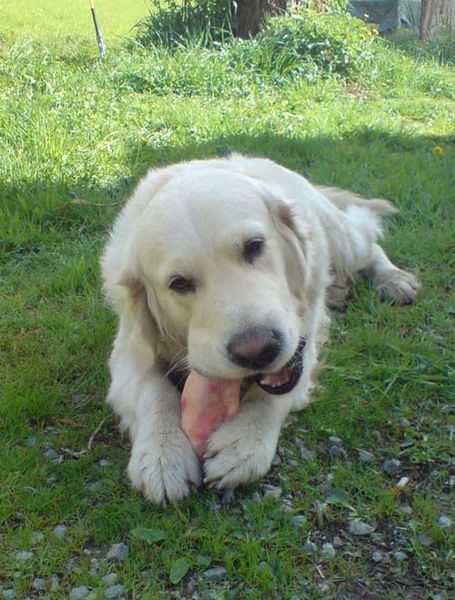 In this article, the reality of feeding raw pet food to your beloved furry companions is examined in detail. Going raw with your pet involves much more than just switching from bagged store kibble to raw meat. The right combination of meat, bones, and organs in homemade dog food recipes and DIY cat chow must be used to ensure your pet’s optimal health and overall adjustment to the change.
In this article, the reality of feeding raw pet food to your beloved furry companions is examined in detail. Going raw with your pet involves much more than just switching from bagged store kibble to raw meat. The right combination of meat, bones, and organs in homemade dog food recipes and DIY cat chow must be used to ensure your pet’s optimal health and overall adjustment to the change.
In addition, the economics of feeding your pet raw pet food is discussed. Is it really possible to do this on a tight budget? What quality of meats need to be purchased and where is the best place to get these items at an affordable price?
If feeding your pet raw is a new concept to you, be sure to first read this article first – The Top Ten Reasons to Feed Your Pet Raw.
Prey Model Diet
A diet of whole raw foods for pets is sometimes also called a “prey model” diet. This is because it’s modeled on the type of nourishment that’s generally provided to our pets’ wild carnivorous canine or feline cousins in the form of an average prey animal.
There are two ways to feed a prey model diet:
The first way is to feed whole intact prey critters. This means feeding entire, unbutchered animals, complete with such things as fur, feathers, scales, skin, heads, organs, glands and entrails etc.
The second, more common method is affectionately known in raw feeding circles as ‘frankenprey,’ and is comprised of an assemblage of parts and pieces of raw hunks of boneless meat, raw meaty bones, and raw organs. These parts are fed, over the course of time rather than at every meal, in the approximate proportions that are found in a prey critter. These approximate ratios are:
- 80-85% raw boneless meat.
- 10% raw meaty bones — aka RMBs.
- 5-10% raw organ meats, at least half of which consists of raw liver.
** Please note that these ratios are approximate, and as such, are only meant to be used as general guidelines. In other words they are in no way intended to be considered as hard-and-fast-set-in-stone rules. **
It’s also possible to combine the two methods by feeding the occasional intact critter when possible and feeding frankenprey the rest of the time.
Putting the Raw Pet Food Diet Together
Assembling a raw pet food diet for our furry friends is neither difficult nor complicated, and is actually quite simple and straightforward. All that’s required is a working understanding of the theory behind the prey model diet, some advance planning, and a bit more time and effort than simply opening a can or bag of cooked, processed pet food and putting it into a bowl. Oh, and having ample freezer space makes the whole endeavor infinitely more workable.
The easiest and most convenient way to put this raw pet food together is by:
- Relying on a freezer for storage of the raw food.
- Stocking said freezer with a variety of different kinds of boneless meats, raw meaty bones and organs. Psst! Pets enjoy bone broth too!
- Thawing out enough food for the pet’s meals as needed prior to feeding times.
Variety is Key to Healthy Raw Pet Food
Ideally, it’s best to feed your pet as wide a variety of different raw foods as possible. When feeding frankenprey, choose parts and pieces in the form of boneless meats, RMBs and organs from things like beef, chicken, lamb, pork, rabbit, duck, game hen, goat, bison, venison, ostrich, kangaroo etc.
Cut boneless meats into meal sized portions, and choose RMBs that are appropriately sized for your pet and freeze.
Although ground meat may be fed occasionally, it’s best to feed our pets primarily whole, unground raw foods. That’s because it’s only these minimally processed raw foods, which require the animal to use its teeth and jaws to gnaw, rip and tear them apart, which provide the kind of natural scrubbing, flossing and stimulative actions that are essential to the promotion of optimal oral health.
Economics of Feeding Raw Pet Food
It’s important to remember that just as choosing better quality food for ourselves and our families may cost us more day to day, but is really an incredibly worthwhile long term investment in our health, likewise feeding our pets a wholesome raw food diet is also an investment in their long term health.
Many health-savvy people today have the understanding that the regular consumption of cheap, low quality food today can cost us dearly later in life.
For such forward thinking folks, it’s easy to see how feeding raw pet food to our beloved furry companions instead of one reliant on cheap, low quality commercial pet food may well result in a significant reduction in vet bills over the course of their lives.
Suggestions for feeding raw pet food economically
- Buy in bulk whenever possible.
- Combine your purchasing power with that of others by participating in a buying club.
- Stock up on quantities of items that are on sale.
- Shop at ethnic markets, which often carry a wide variety of raw animal based foods at extremely reasonable prices.
- Make contact with hunters in your area and offer to take their scrap meat and organs which are often discarded.
- Get to know those who process and butcher animals locally, from whom you may also score scraps, organs and other nourishing raw bits on the cheap or perhaps even for free.
- Advertise online on sites like Craigslist or Freecycle, offering to take the meaty contents of freezers that are being cleaned out.
Although for many of us it may not seem particularly ideal to purchase regular grocery store meat since we’re aware that pastured/grass fed is of much higher quality, it’s helpful to maintain a perspective of relativity by realizing how much better raw pet food consisting of conventionally raised meats/RMBs/organs is as compared to feeding our pets a diet of kibble or cooked can food.
Not everyone can afford to feed raw pet food consisting of 100% pastured meats, so it’s good to bear in mind that feeding our furry friends any sort of whole raw foods is infinitely better for them than is feeding them a lifetime of junk commercial pet food, and that we simply do the best we can for our animals as we are able.
Useful Raw Pet Food Resources
Nature’s Prey Model
http://www.rawfedcats.org/nature.htm
Raw Fed Dogs Starter Guide
https://web.archive.org/web/20170516190036/http://www.rawfeddogs.org:80/rawguide.html
Prey Model Raw
Raw Fed Dogs Recipes
http://www.rawfeddogs.net/Recipes/
Carnivore Feed Supplier
https://web.archive.org/web/20130706085709/http://pets.groups.yahoo.com:80/group/CarnivoreFeed-Supplier/
BARF Suppliers in CA
https://web.archive.org/web/20101116031421/http://pets.groups.yahoo.com:80/group/BARF-SUPPLIERS-IN-CA/
Western NY Raw Feeders
https://web.archive.org/web/20130608130440/http://pets.groups.yahoo.com:80/group/WNYRaw/
Washington/Oregon BARF
https://web.archive.org/web/20130707065234/http://pets.groups.yahoo.com:80/group/WAzzuOR_BARF/
Sources and More Information
Dangerous Pet Food Ingredients
Fast and Easy Fix for a Stinky Cat Litter Box
Dirty Secrets of the Pet Food Industry








Wow, this came at the right time for me. I was trying to figure out how I was going to afford feeding my two large dogs a raw diet when we are struggling just to feed ourselves! I hadn’t thought of asking the local butcher for scraps. Thanks so much for posting this!!
How do you keep pets from dragging raw meat, bones, and organs all over the floor inside the house? Could use some guidance here. Thanks!
Train them by taking the food away from them if/when they drag it away from the designated place and bringing it back to wherever you want them to eat.
This is an ongoing battle (many years) with our gang. I am able to block off the opening to our kitchen and keep them in there on the tile. If I get lazy and forget to put up the gate, then turn my back, the family room carpet will look like a murder scene. If it’s nice I’ll also feed outside.
Hi there,
We trained our guys to eat on a large cookie sheet. it has become their “bowl”. it only took a few tries but we put the food out and each time they tried to take the food off of the tray we picked it up and put it back and said “on your tray”. It’s a nice big flat surface that enables them to get at the food from all angles and it is super easy to clean off. It probably took at most a week to train it (they were puppies at the time).
Devan Kirk this might help with Rosie <3
We want to incorporate raw food into our dog’s diet. How can I copy this post, with all the wonderful links? One cannot click on the links or copy them either. Thanks.
You can go to “Darwin’s natural pet products” – it’s a website. It has the same good info on transitioning etc and you can cut and paste as you please, or link as you like.
Feel free to email me and I will send you a copy of the entire article, with links that you can copy and paste into your browser.
linzurich (at) yahoo.com
I started doing this a few weeks ago. I bought an easy to understand book on my kindle. What I do need is a forum of experienced raw feeders where I can ask questions that weren’t answered in the book, altho the author did a a great job. My one dog still eats everything soooooo fast and I worry it’s bad for her.
Feed your dog items that are bigger than her head!
That will slow her down big time!
Here’s a link to the best online forum I know of where you can ask questions of 10s of thousands of raw feeders:
Good stuff
This is one of the most encouraging articles i’ve seen on these blogs in forever. The benefits of raw will manifest themselves in so many wonderful ways – starting with their gums and teeth. Dogs and cats, domestic ones (pets) have the highest rate of gum disease more than any and every other species on earth, including humans (this is due to malnutrition – eating foods with zero biologic activity). U can google dental issues as one of the first signs of malnutrition.
Once more and more folk adopt this idea for their pets, vicariously (?), something might eventually be triggered in their brains that registers as WTF, why am I not doing this across the board? – and with our kids and our families we can have blogs about how to ease humans back to the original, most traditional, (the original tradition) way of eating (with the occaisional side of fries:))
One technical note about the topic post; I never recommend freezing anything – freeezing can do cell damage as well (cells can be ruptured by the freezing process – and then the thawing process). Many nutrients are cuccooned in cells for protection – and for some nutrients that is just how they exist – inside cells.
What I do is simply store my fresh products in area of the fridge that is just above freezing. Very cold, 40 degrees F will sustain your food stuff for months. This will still prevent spoilage (decay) and mold (bacteria build up). If you need to store food for longer than that – there is going to be some inherent nutrient damage anyhoo.
Also it is important to note that light and oxygen will rapidify decay dynamics as well. So too for mold. If you can vacum seal your fresh food products and store them in a dry cool, dark space, this can do as well as super cold storage. It’s really oxygen more than the heat that enables decay dynamics.
Vegetables are good as well for your pets. My friends use turkey meat and mix in raw fresh organic vegetables.
Also we need to get away from thinking that dogs and cats need so many calories. They don’t. Just like humans, we have become accustomed to thinking we need to eat all of the time – and a lot of food as well. This is in part to marketing.
In the wild, big cats and canines don’t eat every day – they go for days with out eating – and then share a kill with the whole pack – and that sustains them for weeks on occaision. I say this to say that when we weight the costs of raw meat – we shouldn’t feel we have to serve up a twenty dollar meal each day.
Yes thank you so much for this!
Thank you!! This is one of the best articles on how to ease into raw feeding that I’ve read in a long time.. So many people get involved with veggies, fruits, grinding, supplements, etc, etc. It’s really fairly simple! I fed my GSD raw for over 7 years and she thrived on the diet. Sadly we lost her to bloat a few years ago. When we get another dog (might be soon) I will do raw right from the start – puppies take to it like nobody’s business!! I was a part of a buying club and I bought chicken, beef, pork, turkey, ostrich, goat, lamb and rabbit. While it was more expensive than kibble, my dog was never sick, needed no supplements or expensive teeth cleaning.
Thanks again for a great guide to raw.
Thank you for this! We are getting ready to ease into raw feeding and this was so helpful.